Identification
Learn to recognize the Asian hornet
Hornets are nearly twice the size of a wasp or honeybee.
A trick: the hornet is larger than a 1 euro coin from head to stinger.
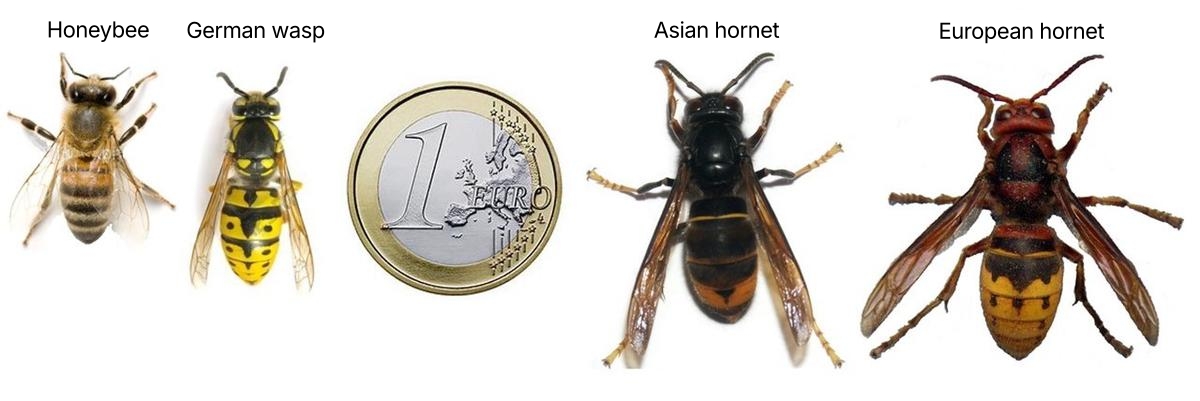
In Belgium, you can find two types of hornets: the Asian hornet and the European hornet.
| Asian hornet | European hornet | |
|---|---|---|
| Queen | 3.5 cm | 4 cm |
| Worker | 2.5 cm - 3 cm | 3 cm - 3.5 cm |
| Drone (male) | 2.5 cm - 3 cm | 3 cm - 3.5 cm |
Black with light yellow legs
You can’t measure a living hornet, but it’s easier to recognize them based on their color patterns.
In short, the Asian hornet is black with yellow legs. Please note that the color can vary. For example, an Asian hornet can fade in color with prolonged flight, and the legs of the European hornet are sometimes yellow instead of reddish-brown. Keep in mind that variation is possible.
You can distinguish the Asian hornet from the European hornet using three simple color characteristics.

Abdomen
| Asian hornet | European hornet |
|---|---|
| black with a dark yellow section |
|
Legs
| Asian hornet | European hornet |
|---|---|
| black with distinct yellow spots |
|
The legs of smaller wasp species are almost entirely yellow.
The upper side of the thorax
The thorax is located between the head and the abdomen. The legs and wings are attached to the thorax.
| Asian hornet | European hornet |
|---|---|
| completely black | black with reddish-brown markings |
The thorax of smaller wasp species is black with distinct yellow stripes or spots.
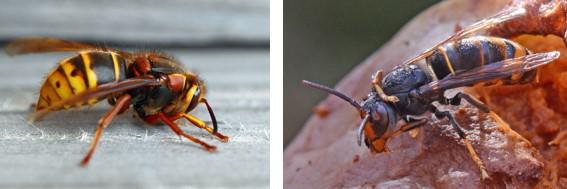 Left photo: queen middle wasp, sometimes a yellow color variation can be seen on reddish-brown legs, (c) Michel Garin. Right photo: black legs with yellow tips of the Asian hornet, (c) Warre-SG.
Left photo: queen middle wasp, sometimes a yellow color variation can be seen on reddish-brown legs, (c) Michel Garin. Right photo: black legs with yellow tips of the Asian hornet, (c) Warre-SG.
Difference between drone and worker
| Drone (or male) | Worker |
|---|---|
|
|
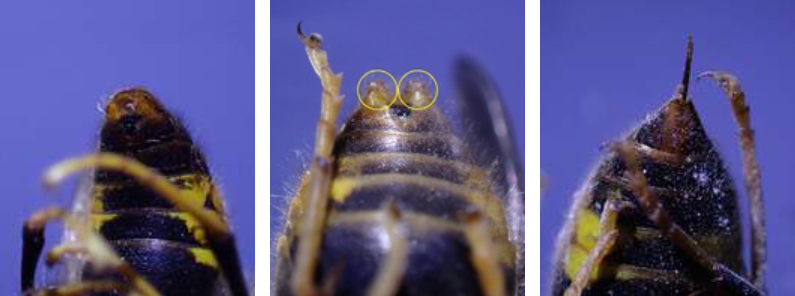 Photo 1: a drone with a blunt abdomen tip. Photo 2: a drone with a clear notch in the middle of the abdomen tip. Yellow circles indicate the yellow spots visible on both sides of the notch. Photo 3: a worker with a tapered abdomen tip, showing the stinger.
Photo 1: a drone with a blunt abdomen tip. Photo 2: a drone with a clear notch in the middle of the abdomen tip. Yellow circles indicate the yellow spots visible on both sides of the notch. Photo 3: a worker with a tapered abdomen tip, showing the stinger.
How to recognize a queen?
In the fall, you can see the difference quite well between a queen and her workers.
You can recognize the queen by:
- Her swollen abdomen
- Her fading orange color
- Less hair on her thorax
- Her damaged wings at the end of the season
The difference between a worker and a potential queen is barely visible to the naked eye. A queen stores fat reserves for the winter, making her heavier than a worker.
Other insects that resemble the Asian Hornet
Common Wasp (Vespula vulgaris) and German Wasp (V. germanica)
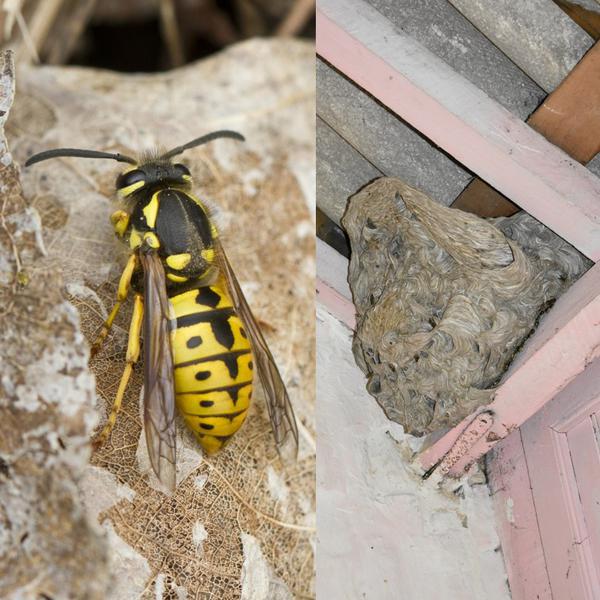
- Size
-
- small wasp species, up to 2 cm in length
- Color
-
- black and yellow
- yellow markings on the thorax
- Nest
-
- paper nest made from chewed wood fibers
- often underground
- What features distinguish them from other wasps?
-
- small size
- yellow markings on the thorax
- yellow abdomen with extensive black markings
Median Wasp (Dolichovespula media), dark form
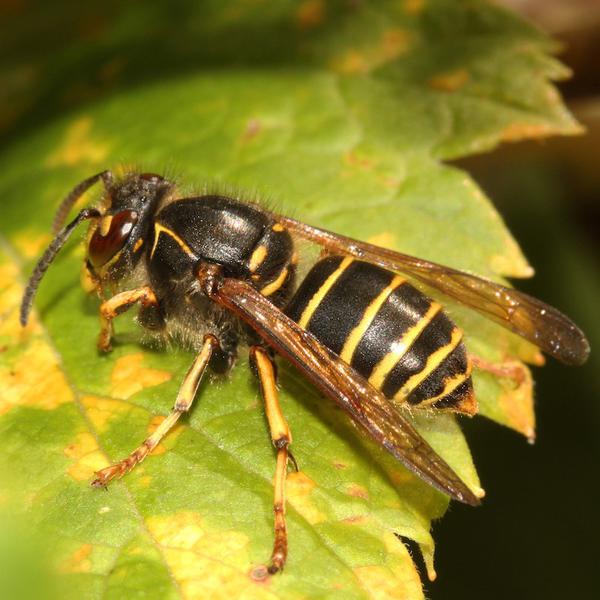
- Size
-
- half the size of the hornet
- Color
-
- striped abdomen with fine yellow and broad black stripes
- legs are yellower than those of the Asian hornet
- black thorax with a yellow, angular stripe on the side
Please note: there is also a light form of the median wasp that closely resembles a common or German wasp.
- Nest
-
- often exposed in a tree below 10 meters
- a pointed bottom, resembling an inverted droplet
- the entrance is at the bottom, never on the side
- the exterior is messy and dull brown to gray
- What features distinguish them from other wasps?
-
- abdomen alternately striped yellow and black
European Paper Wasp (Polistes dominula)
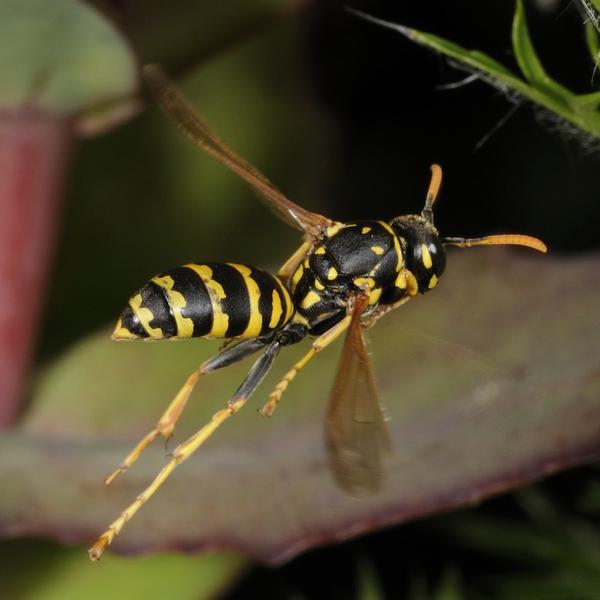
- Size
-
- slightly larger than a bee but smaller and slimmer than a hornet
- Color
-
- yellow and black striped abdomen
- long legs are yellower and dangle in flight
- black thorax with a yellow collar band and some fine yellow spots
- Nest
-
- small and often without an envelope
- usually in a sheltered location
- queens often overwinter in groups outside the nest
- Behavior
-
- less aggressive than other wasps
- What features distinguish them from other wasps?
-
- slender body shape
Giant Horntail (Urocerus gigas)
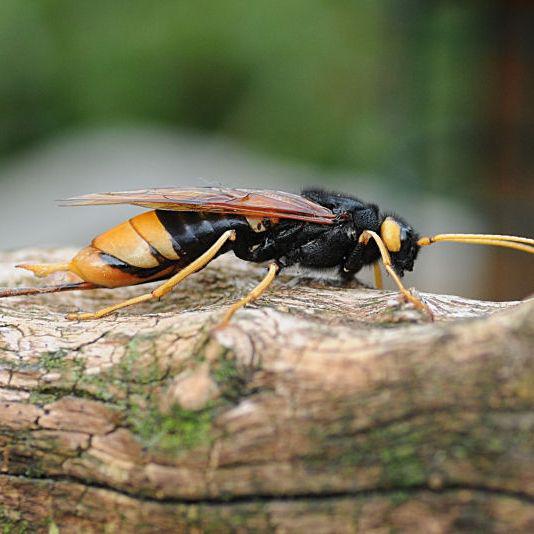
- Size
-
- no stinger: a completely harmless woodwasp
- similar in size but slimmer than an Asian hornet
- Color
-
- abdomen more yellow than black
- legs more yellow than black
- antennae completely yellow (the Asian hornet has black antennae)
- two large yellow facet eyes on the head (dark in the Asian hornet)
- Behavior
-
- often found on wood
- What features distinguish them from other wasps?
-
- broad, protruding ovipositor at the rear of the body
- yellow antennae
Bumblebee (Bombus species)
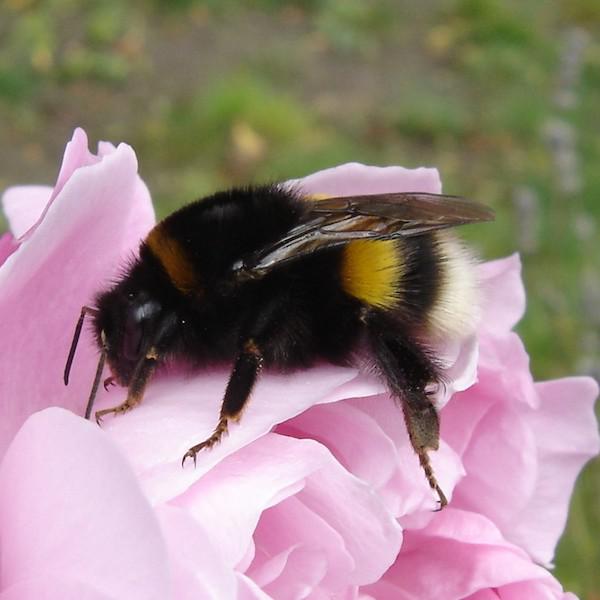
- Size
-
- workers between wasp and hornet
- queen as large as a hornet but wider
- Color
-
- variable
- usually brown or black with a white rear end and yellow bands
- Nest
-
- underground, flower box, garden shed, birdhouse, tree cavity
- What features distinguish them from other wasps?
-
- abundant hair
Hornet mimic hoverfly (Volucella zonaria)
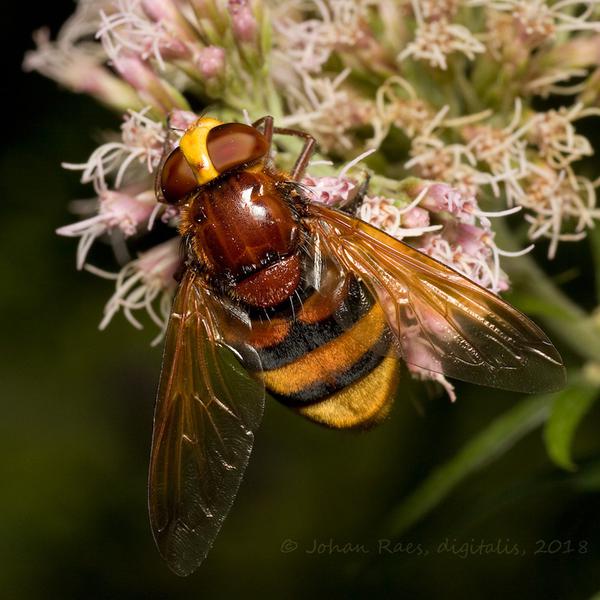
- Size
-
- between wasp and hornet
- sometimes as large as or wider than a hornet
- Color
-
- little black
- a lot of reddish-brown on the thorax
- resembles a European hornet
- Behavior
-
- often found on a flower
- What features distinguish them from other wasps?
-
- hovers in the air
- wings spread at rest
Violet Carpenter Bee (Xylocopa violaceae)
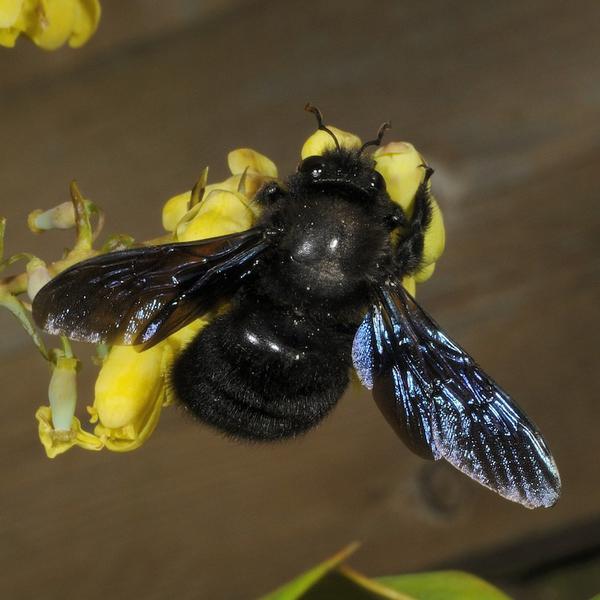
- This one is rather rare in Flanders.
- Size
-
- about the same size but more robust than the Asian hornet
- Color
-
- black
- no other colors unless covered in pollen on the thorax
- blackened wings
- Behavior
-
- often found on large flowers
- What features distinguish them from other wasps?
-
- entirely black
Recognizing nests
The nest of an Asian hornet is light brown and made of dead wood fibers.
Asian hornets prefer to nest in urban areas where there is plenty of food. They build their nest close to humans: in gardens, parks, and the edges of cities. In areas with a lot of agriculture, you’ll find fewer Asian hornets.
There are two types:
- In spring: a small primary nest
- From summer onwards: a large secondary nest
During summer and autumn, the colony grows, and the nest becomes larger. When space is limited, the colony moves and builds a completely new summer nest in a different location. Sometimes, the hornet colony doesn’t move, and it expands the spring nest into a summer nest.
From April to June, the Asian hornet builds a small primary nest in a sheltered place.
- This nest is always spherical.
- The entrance is at the bottom.
- You often find them near water.
- They are sheltered from rain and wind, such as inside a shed, a veranda, a garden house, a wooden shed, an attic, or under the roof of a carport.
- They usually hang from a ceiling or beam.
- Initially, the nest is no larger than a tennis ball. It can be difficult to distinguish from nests of European hornets or other wasps. Later, the nest can grow as large as a small soccer ball.
 Left: a young primary nest hangs from a ceiling (diameter: 8 cm). Right: a more developed primary nest in a shed. Both nests are built in a sheltered place and closely resemble nests of other wasps.
Left: a young primary nest hangs from a ceiling (diameter: 8 cm). Right: a more developed primary nest in a shed. Both nests are built in a sheltered place and closely resemble nests of other wasps.
From summer onwards, the Asian hornet builds a larger secondary nest in a treetop.
- Asian hornets typically build their summer nest in a treetop. You find these nests less easily. You can see them clearly only when the leaves fall from the trees.
- Sometimes, the summer nest can be in a hedge, a shed, under an eave, or against a facade.
- Summer nests are spherical to pear-shaped.
- The entrance is always on the side.
- A summer nest is on average 50 cm wide and 70 cm high.
- During summer and autumn, the nest is active. You can see hornets flying to and from the nest.
- Sometimes, hornets walk on the outside of the nest. This results in black dots on the light brown nest.
 Summer nests at the same location as the primary spring nest. The entrance of the secondary nest is on the side. Hornets often react very aggressively if people approach this kind of nest too closely. Always maintain a safe distance of at least 5 meters.
Summer nests at the same location as the primary spring nest. The entrance of the secondary nest is on the side. Hornets often react very aggressively if people approach this kind of nest too closely. Always maintain a safe distance of at least 5 meters.
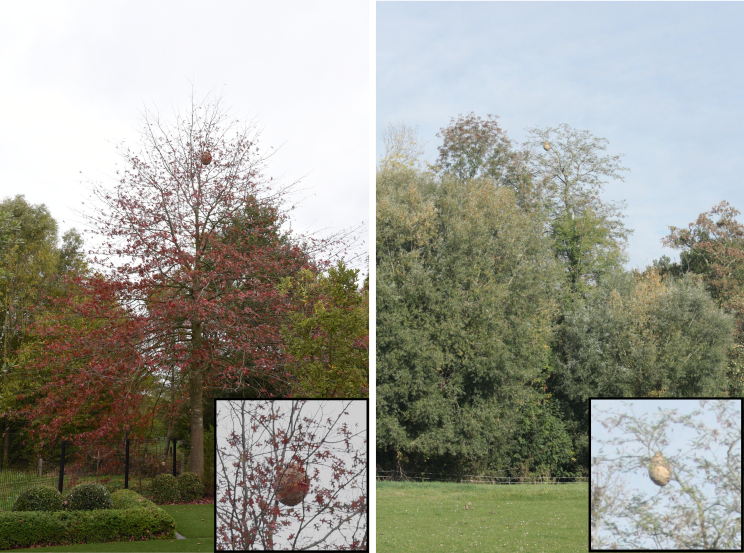 Two summer nests found in October 2018 in Flanders. Left: a light brown sphere hangs 8 meters high in an oak tree at the back of a garden (East Flanders). Right: a pear-shaped nest hangs 26 meters high in a robinia tree (West Flanders). In the bottom right, there’s an enlargement of each nest in the treetop.
Two summer nests found in October 2018 in Flanders. Left: a light brown sphere hangs 8 meters high in an oak tree at the back of a garden (East Flanders). Right: a pear-shaped nest hangs 26 meters high in a robinia tree (West Flanders). In the bottom right, there’s an enlargement of each nest in the treetop.
Can you spot the difference from a mistletoe, a bird’s nest, tree canker, or tinder fungus?
Bird’s Nests
Large nests of magpies, crows, or pigeons can sometimes cause confusion. How do you distinguish them?
- A bird’s nest is loosely built and consists of loose, protruding twigs. The exterior of the sphere is not smooth like a wasp nest.
- A bird’s nest is darker than a wasp nest. Wasp nests are light brown and usually less noticeable.
- If in doubt, observe from a safe distance to see if you spot hornets around the nest.
Mistletoe
Mistletoe is a hemiparasite that grows on deciduous trees. The Black Poplar is the main host. You mainly see mistletoe in Flanders in the southern part of Flemish Brabant and in the eastern loam region of Limburg.
How do you distinguish between mistletoe in a treetop and an Asian hornet nest? Mistletoe is darker and more conspicuous than a wasp nest.
Tree Canker
Sometimes, you see a large growth on a tree trunk or branch. It’s a fungus or a bacterial infection. In popular terms, it’s sometimes referred to as “tree canker.” Usually, the growth is in the lower part of the tree, close to the trunk. A wasp nest is found at the top of the tree.
Tinder Fungi
Sometimes, tinder fungi can be confused with wasp nests in trees. Tinder fungi are a type of fungus that grows on the trunk of a weakened or dead tree.
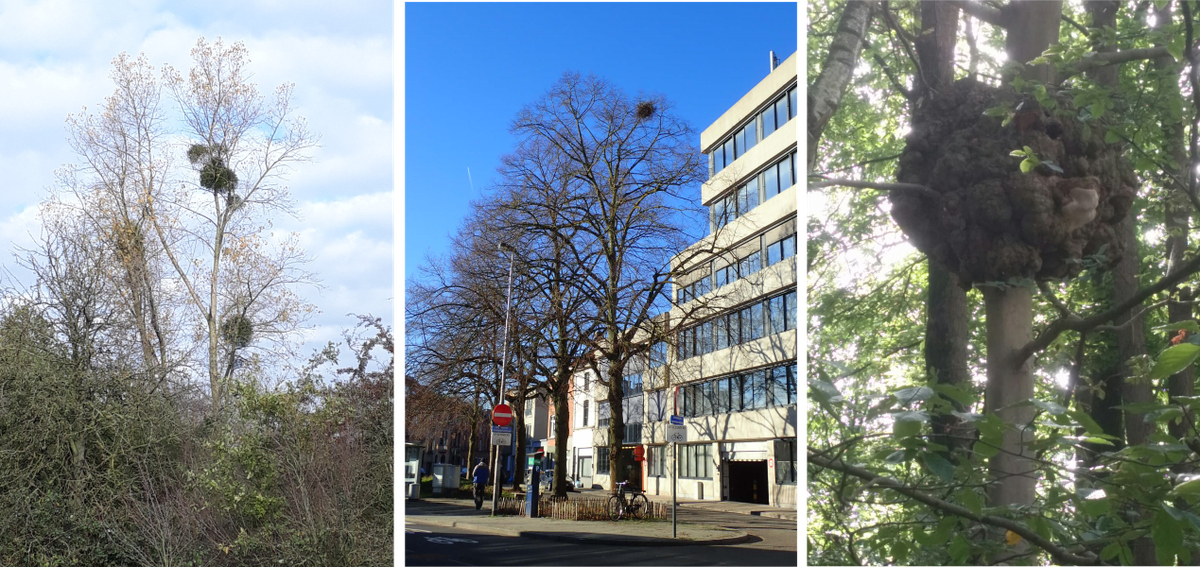 Mistletoe (left), a bird’s nest (middle), or tree cankers (right) can sometimes be mistaken for Asian hornet nests. Tip: they are usually darker than a hornet’s nest.
Mistletoe (left), a bird’s nest (middle), or tree cankers (right) can sometimes be mistaken for Asian hornet nests. Tip: they are usually darker than a hornet’s nest.